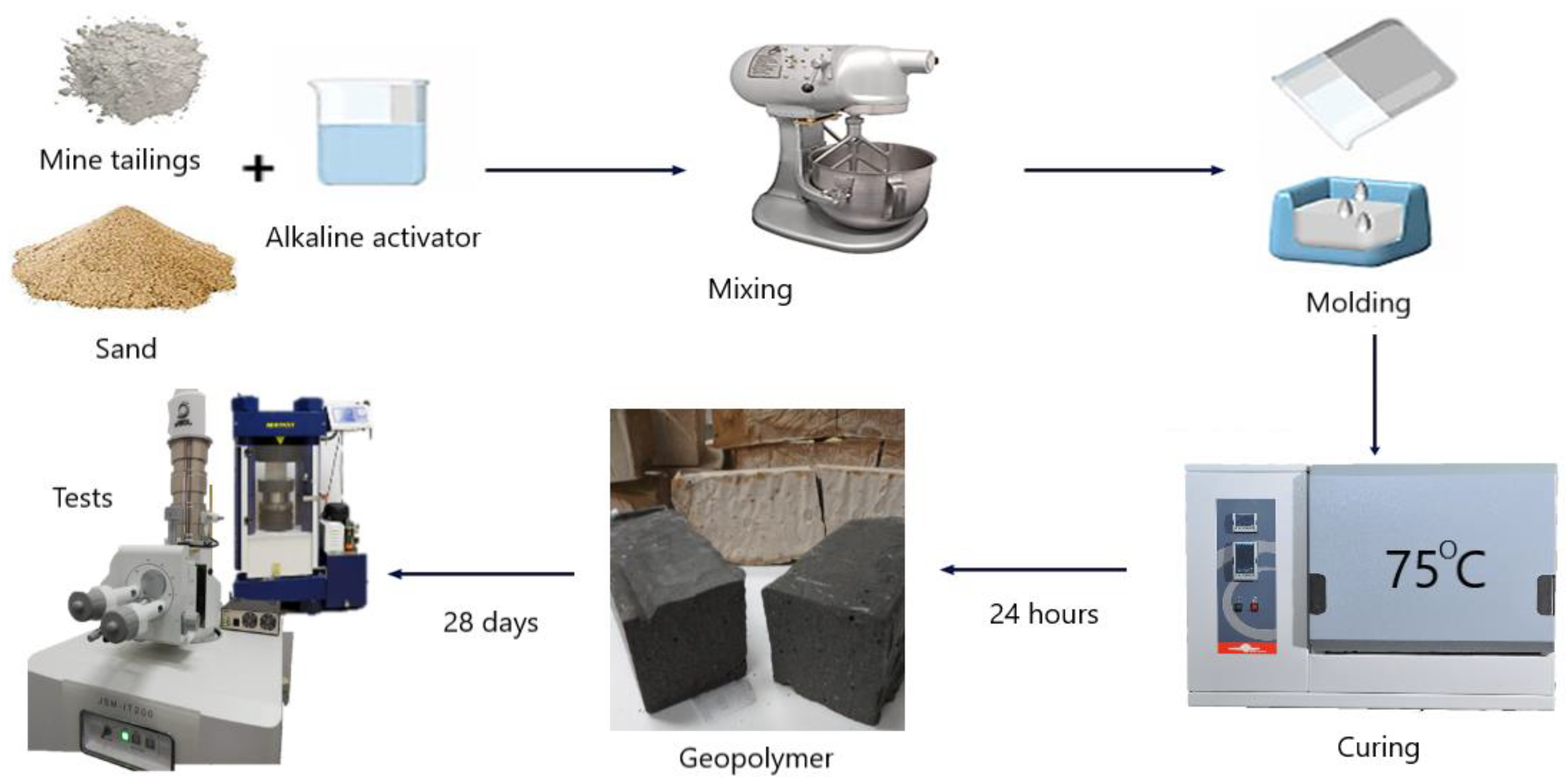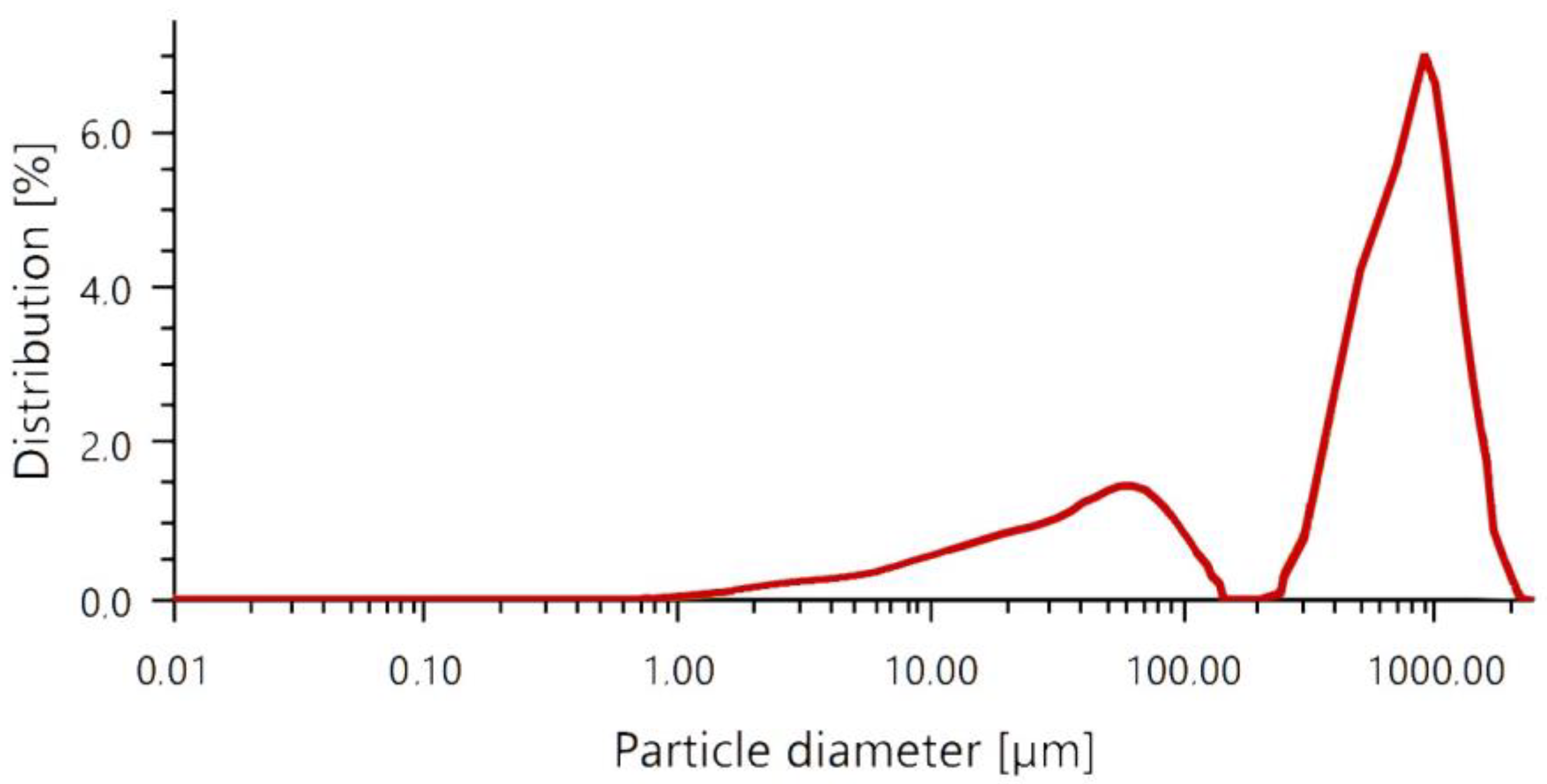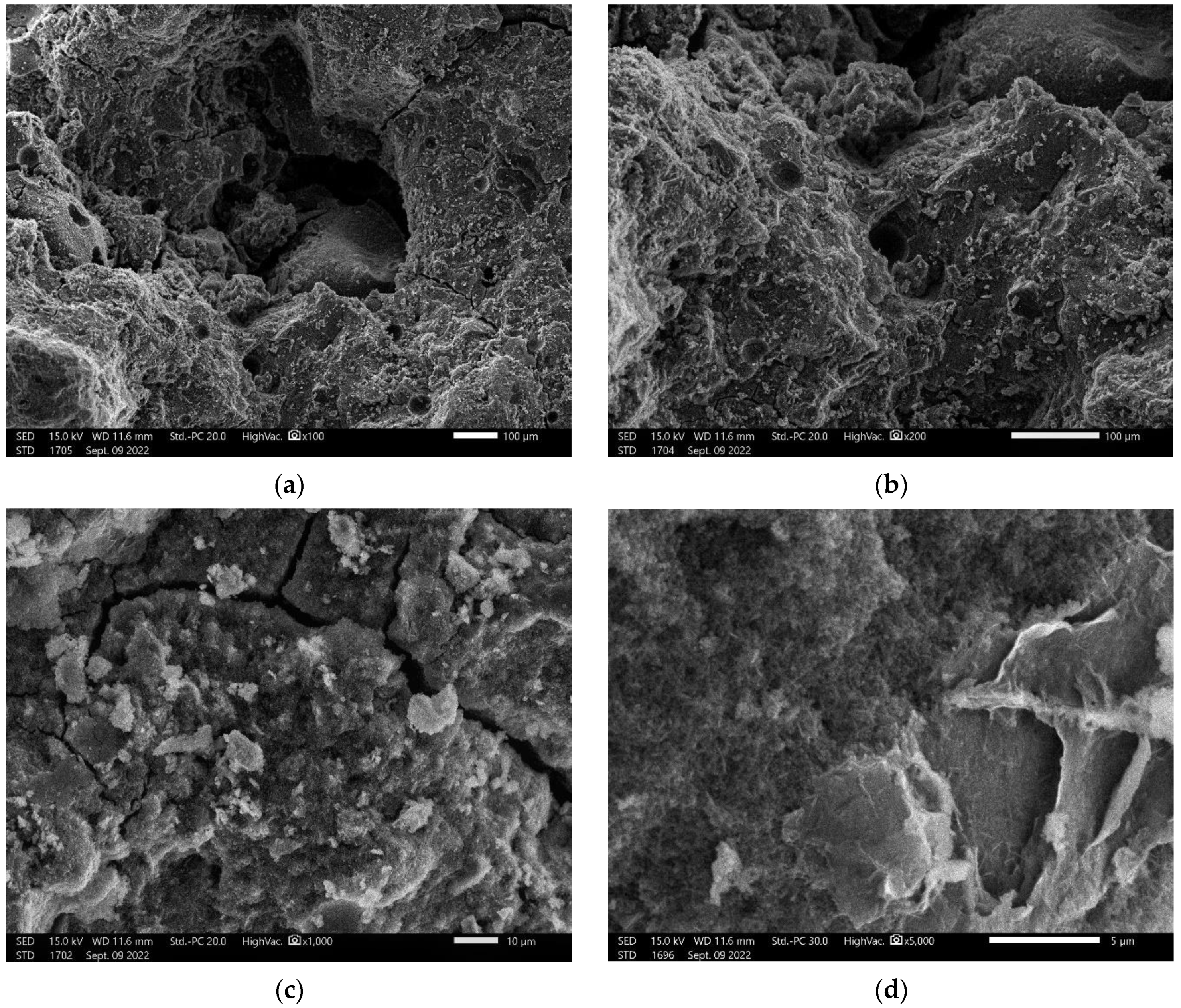Characterization of a Coal Shale from Marcel Mining as Raw Material for Geopolymer Manufacturing †
Abstract
:1. Introduction
2. Materials and Methods
2.1. Materials
2.2. Samples Preparation
2.3. Methods
- PN-EN 12390-3:2019-07—Testing Hardened Concrete—Part 3: Compressive Strength of Test Specimens.
- PN-EN 12390-5:2019-08—Testing Hardened Concrete—Part 5: Flexural Strength of Test Specimens.
3. Results and Discussion
3.1. Physical Properties
3.2. Mechanical Properties
3.3. Microstructure Investigation
4. Conclusions
Author Contributions
Funding
Institutional Review Board Statement
Informed Consent Statement
Data Availability Statement
Acknowledgments
Conflicts of Interest
References
- Vargas-Merino, J.A.; Rios-Lama, C.A.; Panez-Bendezú, M.H. Circular Economy: Approaches and Perspectives of a Variable with a Growing Trend in the Scientific World—A Systematic Review of the Last 5 Years. Sustainability 2022, 14, 14682. [Google Scholar] [CrossRef]
- Figiela, B.; Brudny, K.; Lin, W.-T.; Korniejenko, K. Investigation of Mechanical Properties and Microstructure of Construction- and Demolition-Waste-Based Geopolymers. J. Compos. Sci. 2022, 6, 191. [Google Scholar] [CrossRef]
- Eisenreich, A.; Füller, J.; Stuchtey, M.; Gimenez-Jimenez, D. Toward a circular value chain: Impact of the circular economy on a company’s value chain processes. J. Cleaner Prod. 2022, 378, 134375. [Google Scholar] [CrossRef]
- Khan, S.A.R.; Shah, A.S.A.; Yu, Z.; Tanveer, M. A systematic literature review on circular economy practices: Challenges, opportunities and future trends. J. Entrepreneurship Emerg. Econ. 2022, 14, 754–795. [Google Scholar] [CrossRef]
- Kozub, B.; Bazan, P.; Gailitis, R.; Korniejenko, K.; Mierzwiński, D. Foamed Geopolymer Composites with the Addition of Glass Wool Waste. Materials 2021, 14, 4978. [Google Scholar] [CrossRef] [PubMed]
- Pu, S.; Zhu, Z.; Song, W.; Huo, W.; Zhang, J. Mechanical and microscopic properties of fly ash phosphoric acid-based geopolymer paste: A comprehensive study. Constr. Build. Mater. 2021, 299, 123947. [Google Scholar] [CrossRef]
- Figiela, B.; Korniejenko, K. The possibility of using waste materials as raw materials for the production of geopolymers. Acta Innov. 2020, 36, 48–56. [Google Scholar] [CrossRef]
- McLellan, B.C.; Williams, R.P.; Lay, J.; van Riessen, A.; Corder, G.D. Costs and carbon emissions for geopolymer pastes in comparison to ordinary portland cement. J. Clean. Prod. 2011, 19, 1080–1090. [Google Scholar] [CrossRef]
- Krishna, R.S.; Shaikh, F.; Mishra, J.; Lazorenko, G.; Kasprzhitskii, A. Mine Tailings-Based Geopolymers: Properties, Applications and Industrial Prospects. Ceram. Int. 2021, 47, 17826–17843. [Google Scholar] [CrossRef]
- Sitarz, M.; Figiela, B.; Łach, M.; Korniejenko, K.; Mróz, K.; Castro-Gomes, J.; Hager, I. Mechanical Response of Geopolymer Foams to Heating—Managing Coal Gangue in Fire-Resistant Materials Technology. Energies 2022, 15, 3363. [Google Scholar] [CrossRef]
- Qaidi, S.M.A.; Tayeh, B.A.; Zeyad, A.M.; de Azevedo, A.R.G.; Ahmed, H.U.; Emad, W. Recycling of mine tailings for the geopolymers production: A systematic review. Case Stud. Constr. Mater. 2022, 16, e00933. [Google Scholar] [CrossRef]
- He, X.; Yuhua, Z.; Qaidi, S.; Isleem, H.F.; Zaid, O.; Althoey, F.; Ahmad, J. Mine tailings-based geopolymers: A comprehensive review. Ceram. Int. 2022, 48, 24192–24212. [Google Scholar] [CrossRef]
- Opiso, E.M.; Tabelin, C.B.; Maestre, C.V.; Aseniero, J.P.J.; Park, I.; Villacorte-Tabelin, M. Synthesis and characterization of coal fly ash and palm oil fuel ash modified artisanal and small-scale gold mine (ASGM) tailings based geopolymer using sugar mill lime sludge as Ca-based activator. Heliyon 2021, 7, e06654. [Google Scholar] [CrossRef] [PubMed]
- Silva, I.; Castro-Gomes, J.P.; Albuquerque, A. Effect of immersion in water partially alkali-activated materials obtained of tungsten mine waste mud. Constr. Build. Mater. 2012, 35, 117–124. [Google Scholar] [CrossRef]
- Tian, X.; Xu, W.; Song, S.; Rao, F.; Xia, L. Effects of curing temperature on the compressive strength and microstructure of copper tailing-based geopolymers. Chemosphere 2020, 253, 126754. [Google Scholar] [CrossRef] [PubMed]
- Wan, Q.; Rao, F.; Song, S.; Zhang, Y. Immobilization forms of ZnO in the solidification/stabilization (S/S) of a zinc mine tailing through geopolymerization. J. Mater. Res. Technol. 2019, 8, 5728–5735. [Google Scholar] [CrossRef]
- Wang, A.; Liu, H.; Hao, X.; Wang, Y.; Liu, X.; Li, Z. Geopolymer Synthesis Using Garnet Tailings from Molybdenum Mines. Minerals 2019, 9, 48. [Google Scholar] [CrossRef]
- Krishna, R.S.; Mishra, J.; Meher, S.; Das, S.K.; Mustakim, S.M.; Singh, S.K. Industrial Solid Waste Management through Sustainable Green Technology: Case Study Insights from Steel and Mining Industry in Keonjhar, India. In Proceedings of the Materials Today: Proceedings; Elsevier Ltd.: Amsterdam, The Netherlands, 2020; Volume 33, pp. 5243–5249. [Google Scholar] [CrossRef]
- Zhou, C.; Liu, G.; Wu, S.; Lam, P.K.S. The environmental characteristics of usage of coal gangue in bricking-making: A case study at Huainan, China. Chemosphere 2014, 95, 274–280. [Google Scholar] [CrossRef] [PubMed]
- Korniejenko, K.; Bazan, P.; Figiela, B.; Kozub, B.; Łach, M. Characterization of mine tailings as raw materials for geopolymer synthesis—Mineralogical composition. In Proceedings of the M2D2022: 9th International Conference on Mechanics and Materials in Design, Funchal, Portugal, 26–30 June 2022; pp. 1081–1094. Available online: https://paginas.fe.up.pt/~m2d/proceedings_m2d2022/index.htm (accessed on 12 October 2022).
- Marsh, A.; Heath, A.; Patureau, P.; Evernden, M.; Walker, P. Alkali activation behaviour of un-calcined montmorillonite and illite clay minerals. Appl. Clay Sci. 2018, 166, 250–261. [Google Scholar] [CrossRef]
- Mendes, B.C.; Pedroti, L.G.; Vieira, C.M.F.; Carvalho, J.M.F.; Ribeiro, J.C.L.; Albuini-Oliveira, N.M.; Andrade, I.K.R. Evaluation of eco-efficient geopolymer using chamotte and waste glass-based alkaline solutions. Case Stud. Constr. Mater. 2022, 16, e00847. [Google Scholar] [CrossRef]





| D₁₀ (µm) | D₅₀ (µm) | D₉₀ (µm) | Mean Size (µm) | Mean Size (µm) |
|---|---|---|---|---|
| 19.697 | 548.445 | 1150.324 | 600.729 | 2.062 |
| Sample | Compressive Strength (MPa) | Flexural Strength (MPa) |
|---|---|---|
| 50% mine tailings + 50% sand | 12.7 (±3.3) | 3.4 (±0.2) |
| Identified Phases | Percentage (%) | Chart No. | |
|---|---|---|---|
| Name | Chemical Formula | ||
| Quartz | SiO2 | 11.0 | 01-070-3755 |
| Muscovite-2M1 | KAl2(Si3Al)O10(OH,F)2 | 13.1 | 00-006-0263 |
| Kaolinite-1Ad | Al2Si2O5(OH)4 | 59.5 | 00-058-2006 |
| Illite-2M1 | (K,H3O)Al2Si3AlO10(OH)2 | 16.4 | 00-026-0911 |
Disclaimer/Publisher’s Note: The statements, opinions and data contained in all publications are solely those of the individual author(s) and contributor(s) and not of MDPI and/or the editor(s). MDPI and/or the editor(s) disclaim responsibility for any injury to people or property resulting from any ideas, methods, instructions or products referred to in the content. |
© 2023 by the authors. Licensee MDPI, Basel, Switzerland. This article is an open access article distributed under the terms and conditions of the Creative Commons Attribution (CC BY) license (https://creativecommons.org/licenses/by/4.0/).
Share and Cite
Korniejenko, K.; Figiela, B.; Pławecka, K.; Bulut, A.; Şahin, B.; Azizağaoğlu, G.; Łach, M. Characterization of a Coal Shale from Marcel Mining as Raw Material for Geopolymer Manufacturing. Mater. Proc. 2023, 13, 21. https://doi.org/10.3390/materproc2023013021
Korniejenko K, Figiela B, Pławecka K, Bulut A, Şahin B, Azizağaoğlu G, Łach M. Characterization of a Coal Shale from Marcel Mining as Raw Material for Geopolymer Manufacturing. Materials Proceedings. 2023; 13(1):21. https://doi.org/10.3390/materproc2023013021
Chicago/Turabian StyleKorniejenko, Kinga, Beata Figiela, Kinga Pławecka, Alperen Bulut, Baran Şahin, Göksu Azizağaoğlu, and Michał Łach. 2023. "Characterization of a Coal Shale from Marcel Mining as Raw Material for Geopolymer Manufacturing" Materials Proceedings 13, no. 1: 21. https://doi.org/10.3390/materproc2023013021
APA StyleKorniejenko, K., Figiela, B., Pławecka, K., Bulut, A., Şahin, B., Azizağaoğlu, G., & Łach, M. (2023). Characterization of a Coal Shale from Marcel Mining as Raw Material for Geopolymer Manufacturing. Materials Proceedings, 13(1), 21. https://doi.org/10.3390/materproc2023013021








